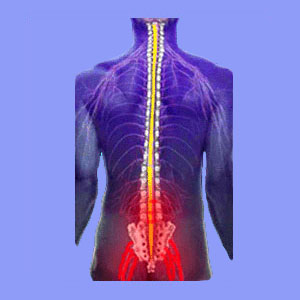
Sciatica incontinence is a dreaded symptom describing the inability to retain urine or feces. Becoming incontinent is rare for sciatica patients, but may be a risk that is associated with some severe diagnoses. Incontinence is one of the worst possible expressions of any spinal pathology and usually signifies the ongoing compression of either the spinal cord or the cauda equina structure. However, it is never wise to assume that incontinence is a direct result of a back or neck syndrome, since there are many other possible explanations for urinary or fecal retention concerns.
This crucial essay provides important information for patients who are suffering incontinence, as well as for patients who fear becoming incontinent in relation to a sciatica pain syndrome. We will examine why sciatica and body waste retention might be linked to the same source process and detail some other scenarios in which sciatica incontinence might not be connected the same causative process as the back and leg symptoms.
Definition of Sciatica Incontinence
Incontinence describes a condition wherein the patient can not control their bladder or bowels adequately or at all. This results in the unwanted leaking or spontaneous passing of urine or feces from their respective bodily orifices.
The urinary and fecal waste systems are controlled by nerve tissues that pass through the spine and might be influenced by compression of the spinal cord anywhere in the vertebral column or impingement on the individual or massed nerve roots in the lower back. This condition may be diagnosed as spinal stenosis, spinal cord compression, cauda equina syndrome or other nomenclature, depending on the particulars and location of the neurological impairment.
Incontinence may be definitively linked to a variety of back and neck pain conditions, but may also come about due to unrelated circumstances and conditions. This is why diagnostic certainty is of utmost importance before treatment is attempted. Remember, in some cases of incontinence, it is vital to ascertain the causative reason for the condition to exist and remedy it quickly in order to preempt damage from occurring to the sensitive neurological tissues that control urinary and fecal waste management. This rush often leads to diagnostic and treatment miscalculations, much to the detriment of the poor patient.
Diagnosis and Misdiagnosis of Incontinence
In order for the correct cause of incontinence to be discovered, the patient must be evaluated by one or more physicians who can determine which possible reasons might best explain the dire symptomology. Neurologists are instrumental in determining if the spine might be part of the causative origin of the condition, while other types of doctors might be asked to evaluate the patient to rule out nonspinal causations.
In some cases, spinal abnormalities exist, but these may not be causative for the incontinence, leading to poor results from spinally-targeted treatments. Remember, many atypical spinal structural issues might be present, but may not be the actual source of any symptomology. We see this problem often in the back and neck pain diagnostic arena, with pain being linked to coincidental noncausative tissue aberrations that are imaged during diagnostic processing, but innocent of being pathological.
Central spinal stenosis anywhere in the vertebral column can cause incontinence when the cord or cauda equina compression is severe. This diagnostic causation can accumulate over time, leading to a slow progressive onset of symptoms, or may happen acutely from traumatic injury, such as a car accident.
Remember that even cervical stenosis can cause sciatica-like symptoms and incontinence, which can be a diagnostic nightmare when other more common lumbar abnormalities exist concurrently. When lumbar causation is suspected, there is usually demonstration of massed cauda equina compression in the lowest levels of the spinal column. However, in select cases, one or more nerve roots may be affected individually and the patient might still demonstrate some degree of symptomology with either urinary or fecal discharge.
Sciatica Incontinence Fact Sheet
Besides being related to sciatica, there are many other possible reasons to explain incontinence that may be completely unrelated to an existing lower back and leg pain syndrome. Some of these more common origins of incontinence include:
Bladder or bowel injury might be causative, even if it occurred long ago or was never positively diagnosed previously.
Side effects of many pharmaceutical products might create incontinence in some patients. This is sometimes seen when sciatica sufferers take large doses of medications for their pain and other health issues together.
Urinary or bowel infection may lead to incontinence.
Hemorrhoids or constipation may factor into minor incontinence issues, as may systemic illness of varying severities.
Weak pelvic muscles due to injury, childbirth or other causes can affect urine and feces retention abilities.
Aging can diminish the ability to retain urine and feces, as can menopause in women.
Prostate problems can lead to various incontinence expressions in men.
It is vital that all these possible causations, as well as others, be considered and ruled out before focusing attention on possible spinal contributors to the incontinence symptoms.
Incontinence Editorial
Statistics show that most threats of becoming incontinent in relation to a spinal issue are unwarranted. Some less ethical physicians have used these scare tactics for decades in order to get patients to quickly acquiesce to surgical treatment.
However, since the risk does exist in very rare cases, it is always safe and prudent to have the condition fully evaluated by a team of physicians, including a spinal neurologist, in order to be fully informed of the true nature of the current symptomology, as well as the prognosis for the future.
When incontinence does occur due to a spinal origin, there is usually no doubt as to the cause, since the central canal will be thoroughly compressed and the patient will virtually always demonstrate a variety of symptoms that all support the diagnostic conclusion of central stenosis. When these other telltale signs are lacking, yet incontinence is present, diagnosticians must be very careful to make assumptions as to the actual cause of urinary or fecal leaking in order to prevent treatment failure and continuing expression post-surgical intervention.
For more information on the very real threat of incontinence related to a spinally-motivated sciatica condition, please speak to an objective non-surgeon neurologist to separate fact from fiction and dispel any incorrect information that may be been possibly gathered from profit-driven, illogical fear-inspiring care providers.





